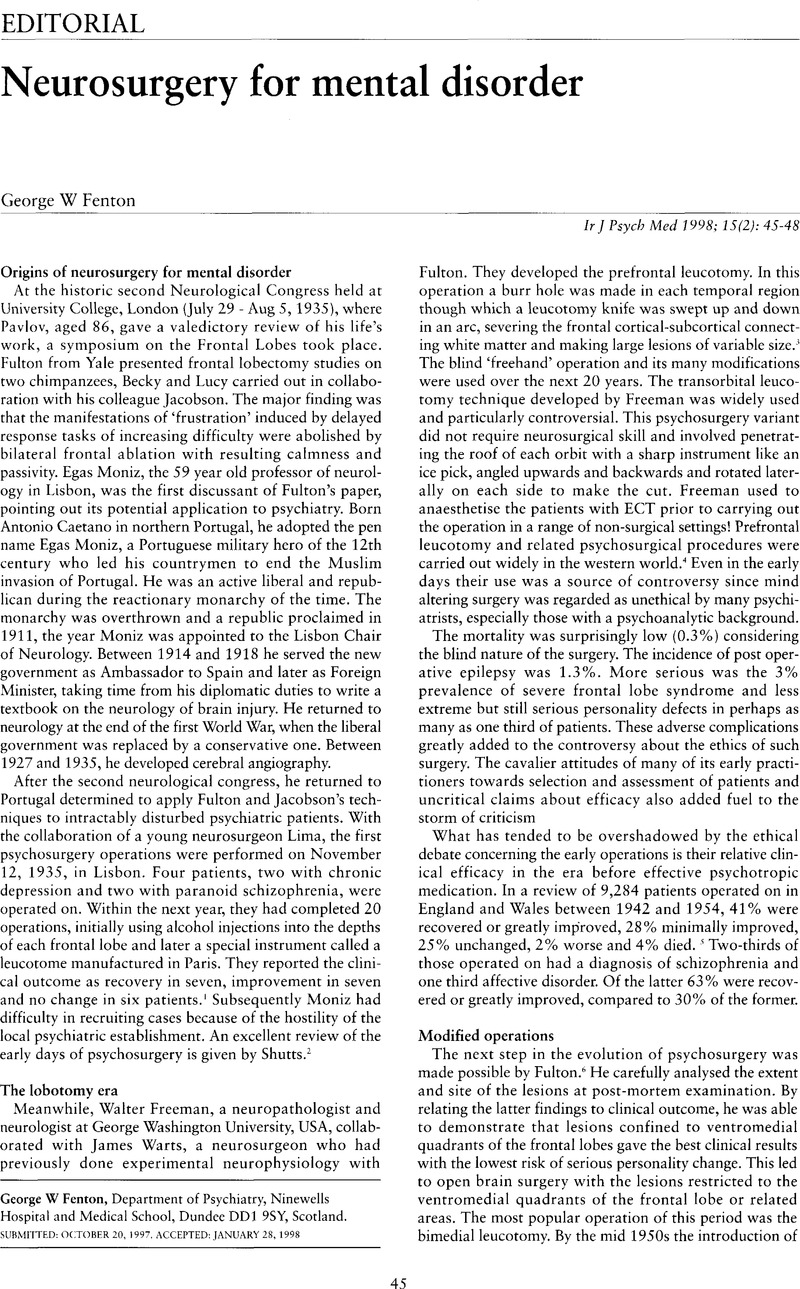No CrossRef data available.
Article contents
Neurosurgery for mental disorder
Published online by Cambridge University Press: 13 June 2014
Abstract
An abstract is not available for this content so a preview has been provided. As you have access to this content, a full PDF is available via the ‘Save PDF’ action button.

- Type
- Editorial
- Information
- Copyright
- Copyright © Cambridge University Press 1998
References
1.Moniz, E. Tentatives operatories dans le traitement de certaines psychoses. Paris: Masson, 1936.Google Scholar
3.Freeman, WJ, Watts, J, Robinson, MF. Psychosurgery: In the treatment of mental disorders and intractible pain. 2nd ed. Springfield: Charles C Thomas, 1950.Google Scholar
4.Swayze, VW. Frontal leukotomy and related psychosurgical procedures in the era before antipsychotics (1935-1954): a historical review. Am J Psychiatry 1995; 152: 505–15.Google Scholar
5.Tooth, GC, Newton, MP. Leucotomy in England and Wales 1942-1954. Reports on public health and medical subjects. No.104, Ministry of Health, London: UNISO, 1961.Google Scholar
6.Fulton, JF. Frontal lobotomy and affect: a neurophysiological analysis. New York: Norton WW, 1951.Google Scholar
7.Bridges, PK, Bartlett, JR, Hale, AS, Poynton, A, Malizia, AL, Hodgkiss, AD. Psychosurgery: stereotactic subcaudate tractotomy. An indispensable treatment. Br J Psychiatry 1994; 165: 599–611.Google Scholar
8.Mindus, P, Rasmussen, SA, Lindquist, C. Neurosurgical treatment for refractory obsessive-compulsive disorder: implications for understanding frontal lobe function. J Neuropsych Clin Neuroscience 1994; 6: 467–77.Google Scholar
9.Baer, L, Rauch, SL, Ballantine, HTet al.Cingulotomy for intractible obsessive-compulsive disorder: a prospective long-term follow-up of 18 patients. Arch Gen Psychiatry 1995; 52: 384–92.Google Scholar
10.Kitchen, N. Neurosurgery for affective disorders at Atkinson Morley's Hospital 1948-1994. Acta Neurochir Suppl (Wien) 64: 64–8.Google Scholar
11.Hussain, ES, Freeman, H, Jones, RAC. A cohort study of psychosurgery cases from a defined population. J Neurol Neurosurg Psychiatry 1988; 51: 345–52.CrossRefGoogle ScholarPubMed
12.Hay, P, Sachdev, P, Cumming, Set al.Treatment of obsessive-compulsive disorder by psychosurgery. Acta Psychiatr Scand 1993; 87: 197–202.Google Scholar
13.Mindus, P, Nyrnan, H. Normalisation of personality characteristics in patients with incapacitating anxiety disorders after capsulotomy. Acta Psychiatr Scand 1991; 83: 282–91.CrossRefGoogle ScholarPubMed
14.Sachdev, P and Hay, P. Does neurosurgery for obsessive-compulsive disorder produce personality change? J Nerv Ment Dis 1995; 183: 408–13.CrossRefGoogle ScholarPubMed
15.Kiloh, LG, Smith, JS, Johnson, GF. Physical treatments in psychiatry. Melbourne: Blackwell Science, 1988: 277–333.Google Scholar
16.Kartsouris, LD, Poynton, A, Bridges, PK, Bartlett, JR. Neuropsychological correlates of stereotactic subcaudate tractotomy: a prospective study. Brain 1991; 114: 2657–73.Google Scholar
17.Neurosurgery for mental disorder. A report by a Good Practice Group of the CRAG Working Group on Mental Illness. The Scottish Office, Edinburgh: HMSO, 1996.Google Scholar
18.Bird, JM, Crow, CD. Psychosurgery in obsessive-compulsive disorder. In: Montgomery, SA, Goodman, WK, Goeting, N, eds. Obsessive-compulsive disorder. Duphar Medical, 1990: 82–92.Google Scholar
19.Crow, HJ. Controlled multifocal frontal leucotomy for psychiatric illness. J Neurol Neurosurg Psychiatry 1961; 24: 353–60.Google Scholar
20.Snaith, RP. Psychosurgery: controversy and enquiry. Br J Psychiatry 1994; 165: 582–4.Google Scholar
21.Sachdev, P, Sachdev, J. Sixty years of psychosurgery: its present status and its future. Aust N Z J Psychiatry 1997; 31: 457–64.Google Scholar




